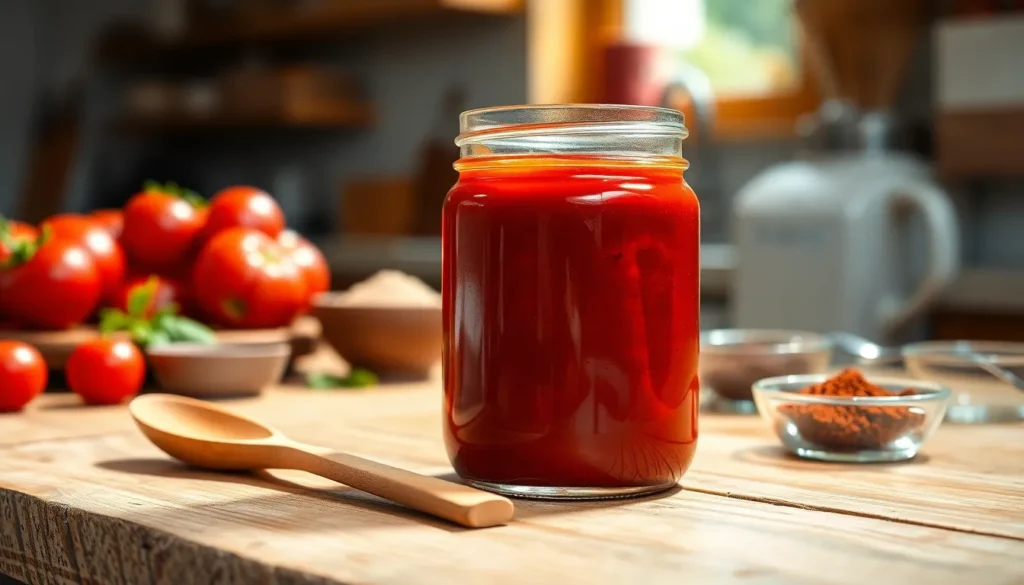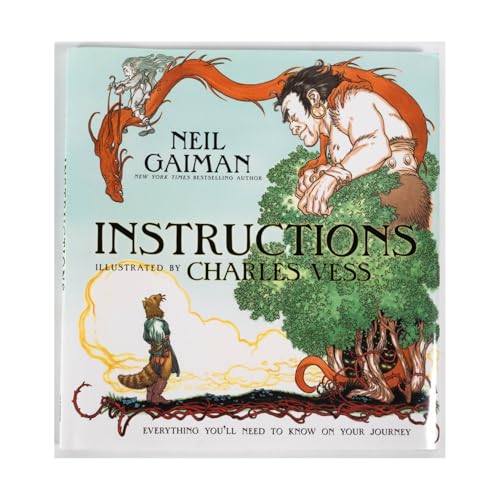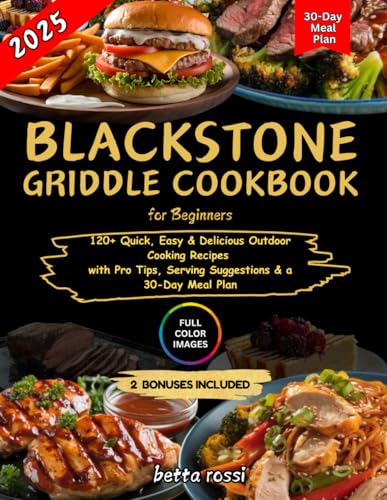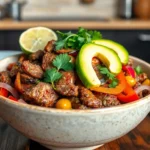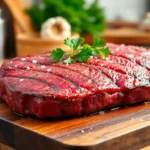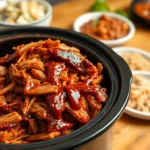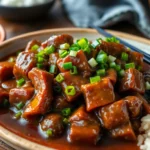Nothing beats the smoky-sweet satisfaction of homemade BBQ sauce slathered on your favorite grilled meats. While store-bought bottles line grocery shelves we’ve discovered that making your own BBQ sauce transforms ordinary backyard cookouts into unforgettable flavor experiences. The magic happens when you control every ingredient from the tangy vinegar base to the perfect balance of spices.
We’re sharing our foolproof recipe that delivers restaurant-quality results right from your kitchen. This versatile sauce works beautifully as a marinade glaze or dipping sauce – and it’s surprisingly simple to make. You’ll need just a handful of pantry staples and about 20 minutes to create a sauce that’ll have your guests begging for the recipe.
The best part? You can customize the heat level and sweetness to match your family’s preferences perfectly.
Ingredients
This homemade BBQ sauce recipe requires just a handful of pantry staples that you likely already have on hand. We’ve organized the ingredients by category to make shopping and preparation effortless.
Base Ingredients
- 1 cup ketchup
- 1/2 cup apple cider vinegar
- 1/4 cup water
- 2 tablespoons Worcestershire sauce
- 1 tablespoon yellow mustard
- 1 medium onion, finely diced
Sweeteners
- 1/4 cup brown sugar, packed
- 2 tablespoons honey
- 1 tablespoon molasses
Spices and Seasonings
- 2 teaspoons smoked paprika
- 1 teaspoon garlic powder
- 1 teaspoon onion powder
- 1/2 teaspoon black pepper, freshly ground
- 1/2 teaspoon salt
- 1/4 teaspoon cayenne pepper
- 1/4 teaspoon celery seed
Optional Flavor Enhancers
- 1 tablespoon tomato paste (for deeper richness)
- 1 teaspoon liquid smoke (for extra smokiness)
- 1 chipotle pepper in adobo, minced (for heat and complexity)
- 1 tablespoon bourbon (for depth)
- 1 teaspoon soy sauce (for umami)
Equipment Needed
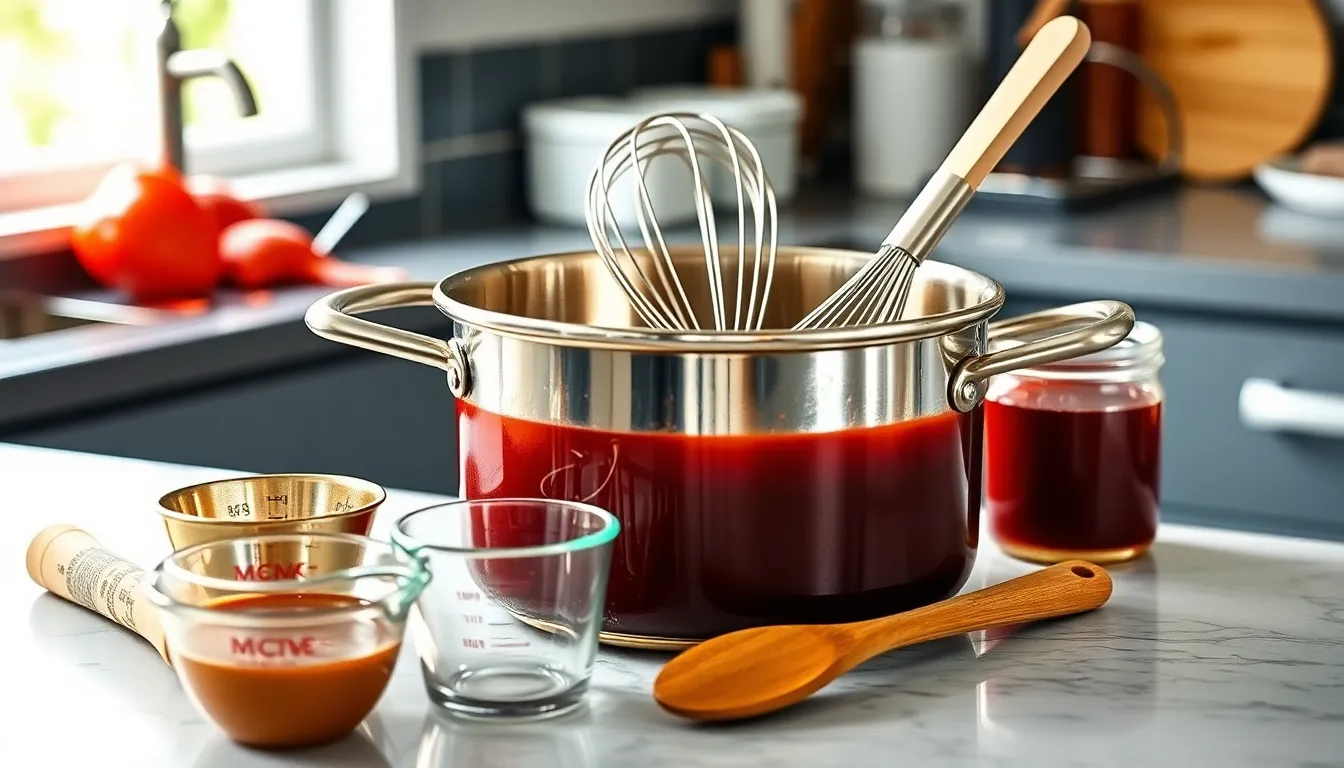
Creating restaurant-quality BBQ sauce at home requires minimal kitchen equipment that most home cooks already have on hand. We’ll walk you through the essential tools needed to make this flavorful sauce from scratch.
Large saucepan or pot serves as our primary cooking vessel for combining and simmering all ingredients together. This allows the flavors to meld properly while providing enough space for stirring without spillage.
Measuring cups and spoons ensure precision when adding each ingredient to achieve the perfect balance of sweet, tangy, and smoky flavors. Accurate measurements are crucial for consistent results every time we make this sauce.
Whisk or wooden spoon helps us mix the sauce smoothly and prevents ingredients from sticking to the bottom of the pan during cooking. We recommend using a whisk for initial mixing and switching to a spoon for stirring during the simmering process.
Storage container or jar with an airtight lid keeps our finished BBQ sauce fresh in the refrigerator for up to three weeks. Glass jars work particularly well as they don’t absorb flavors and make it easy to see how much sauce remains.
These basic kitchen tools make the sauce-making process straightforward and efficient. Having everything ready before we start cooking ensures smooth preparation and helps us focus on developing those rich, complex flavors that make homemade BBQ sauce superior to store-bought versions.
Instructions
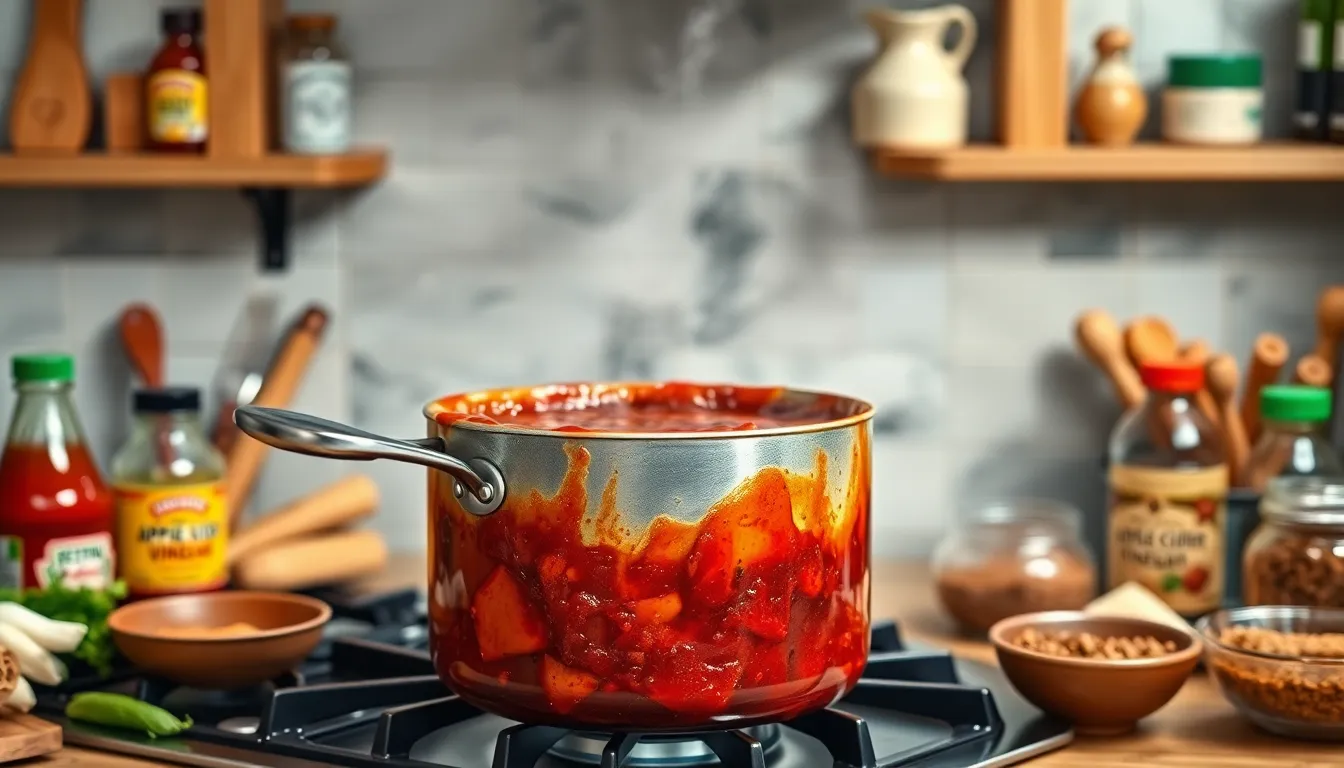
We’ll walk you through our foolproof five-step process that transforms simple pantry ingredients into restaurant-quality BBQ sauce. Each step builds upon the last to create perfectly balanced flavors and ideal consistency.
Prep the Base
We start by measuring 1 to 2 cups of ketchup or tomato sauce into our large saucepan. This tomato foundation provides the classic BBQ sauce color and body that serves as our flavor canvas. Ketchup works exceptionally well because it already contains vinegar and sweeteners that complement our additional ingredients.
Combine Wet Ingredients
We add our liquid components to create the sauce’s signature sweet and tangy profile. Pour in ½ to ⅔ cup of apple cider vinegar or red wine vinegar for that essential acidic bite. Next, we incorporate ¼ to ⅔ cup of brown sugar or molasses to balance the acidity with rich sweetness. We then add 1 to ¼ cup of Worcestershire sauce or tamari for deep umami complexity. Water can be added gradually if we need to adjust the consistency during cooking. Optional additions like honey or prepared mustard enhance flavor complexity and can be stirred in at this stage.
Add Spices and Seasonings
We build our spice blend by whisking in ½ teaspoon of smoked or regular paprika for color and depth. Our essential trio of garlic powder, onion powder, and ground mustard gets added next, using about ¼ teaspoon of each for aromatic foundation. Salt and black pepper go in to taste, typically starting with ½ teaspoon of salt. Heat lovers can incorporate cayenne pepper or hot sauce at this point. Additional spices like chili powder and a pinch of cinnamon create unique flavor notes that set our sauce apart from store-bought versions.
| Cooking Phase | Temperature | Time | Texture Goal |
|---|---|---|---|
| Initial Boil | Medium Heat | 2-3 minutes | Bubbling |
| Simmer Phase | Medium-Low Heat | 20-30 minutes | Thick coating consistency |
Simmer and Thicken
We bring our mixture to a rolling boil over medium heat while stirring frequently to prevent sticking. Once bubbling, we reduce the heat to medium-low and let the sauce simmer uncovered for 20 to 30 minutes. Stirring every few minutes ensures even cooking and prevents scorching. The sauce is ready when it coats the back of our spoon and has reduced by about one-third of its original volume.
Taste and Adjust
We remove our sauce from heat and conduct our final flavor assessment. More brown sugar goes in if we want additional sweetness, while extra vinegar brightens the tanginess. Spice levels can be boosted with cayenne or hot sauce to match our heat preference. The sauce should rest and cool for at least one hour in the refrigerator before serving, allowing all flavors to meld together perfectly. This resting period transforms good sauce into exceptional sauce that rivals any restaurant version.
Cooking Tips for Perfect BBQ Sauce
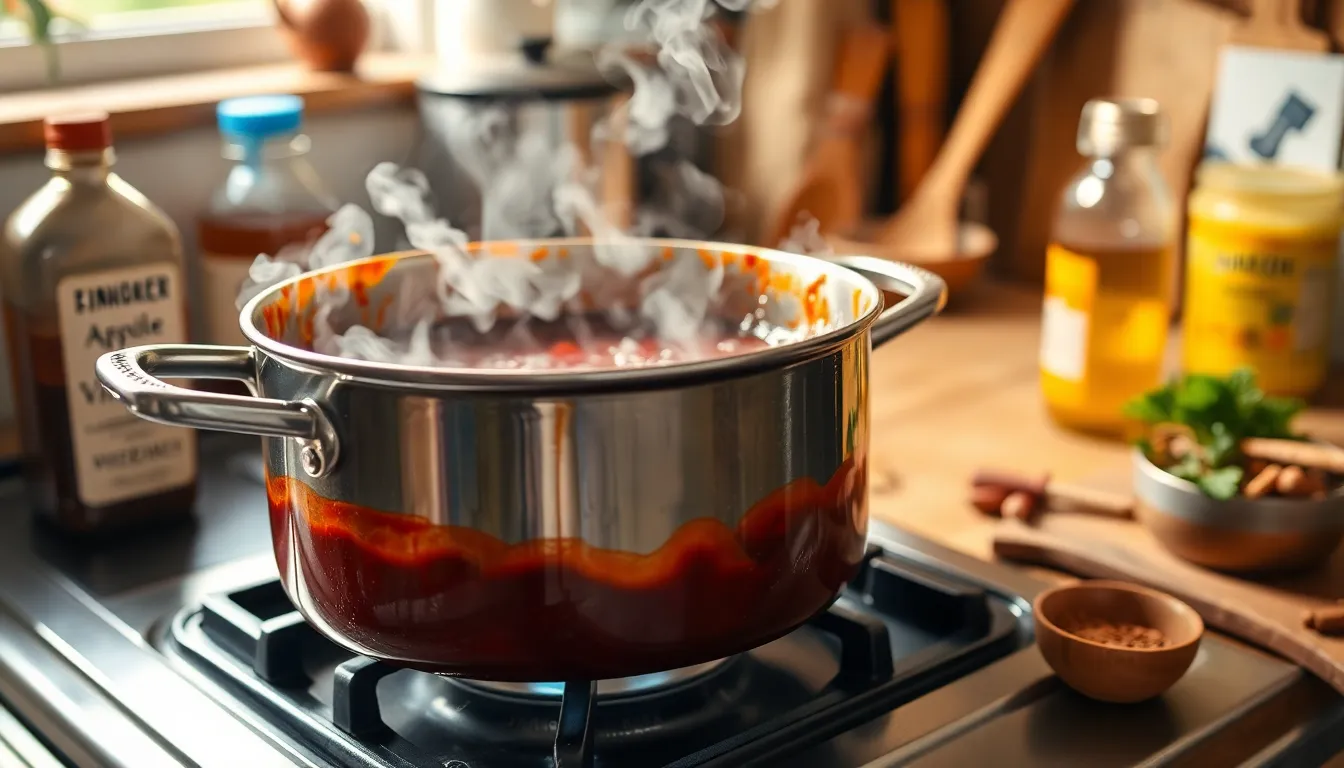
Mastering homemade BBQ sauce requires attention to key details that separate good sauce from exceptional sauce. These proven techniques will help you create restaurant-quality results every time.
Achieving the Right Consistency
Simmering transforms your sauce from a thin mixture into a rich coating that clings beautifully to meat. We recommend cooking the sauce for 10-20 minutes after bringing it to a boil, though you can extend this to an hour for deeper flavor concentration. The mixture will thicken naturally as moisture evaporates during the cooking process.
Temperature control plays a crucial role in developing proper consistency. Keep the heat at medium-low to prevent scorching while allowing gradual reduction. Stir occasionally to prevent sticking and ensure even thickening throughout the saucepan.
Remember that cooling will further thicken your sauce significantly. What appears slightly thin while hot will reach perfect coating consistency once it reaches room temperature. Adjust liquid components like water or additional vinegar if the mixture becomes too thick during cooking.
Balancing Sweet and Tangy Flavors
Creating the perfect sweet and tangy balance requires careful layering of complementary ingredients. Brown sugar provides deep caramelized sweetness while honey adds floral notes and molasses contributes robust complexity. Start with moderate amounts and build gradually to avoid overwhelming the sauce.
Acidity comes primarily from apple cider vinegar or red wine vinegar, each offering distinct flavor profiles. Apple cider vinegar delivers mild fruitiness that pairs beautifully with brown sugar, while red wine vinegar provides sharper acidity that cuts through rich meats effectively.
Taste testing throughout the cooking process allows for real-time adjustments. Too much sweetness can mask tangy elements completely, while excessive vinegar creates harsh sharpness that overpowers other flavors. Balance emerges when neither sweet nor tangy dominates but instead creates harmonious complexity.
Avoiding Common Mistakes
Burning sugar ranks among the most frequent pitfalls when making BBQ sauce. We prevent this by maintaining consistent stirring and keeping temperatures at medium-low throughout the simmering process. Sugar burns quickly once it reaches certain temperatures, creating bitter flavors that cannot be corrected.
Over-thickening represents another common error that compromises final results. Monitor consistency carefully since sauce continues thickening as it cools. What seems perfect while hot may become paste-like at room temperature, making it difficult to brush or pour.
Fresh ingredients make important differences in final flavor quality. Check expiration dates on spices and replace any that smell weak or stale. Store finished sauce in airtight containers to maintain peak freshness and prevent flavor deterioration over the recommended storage period.
Flavor Variations
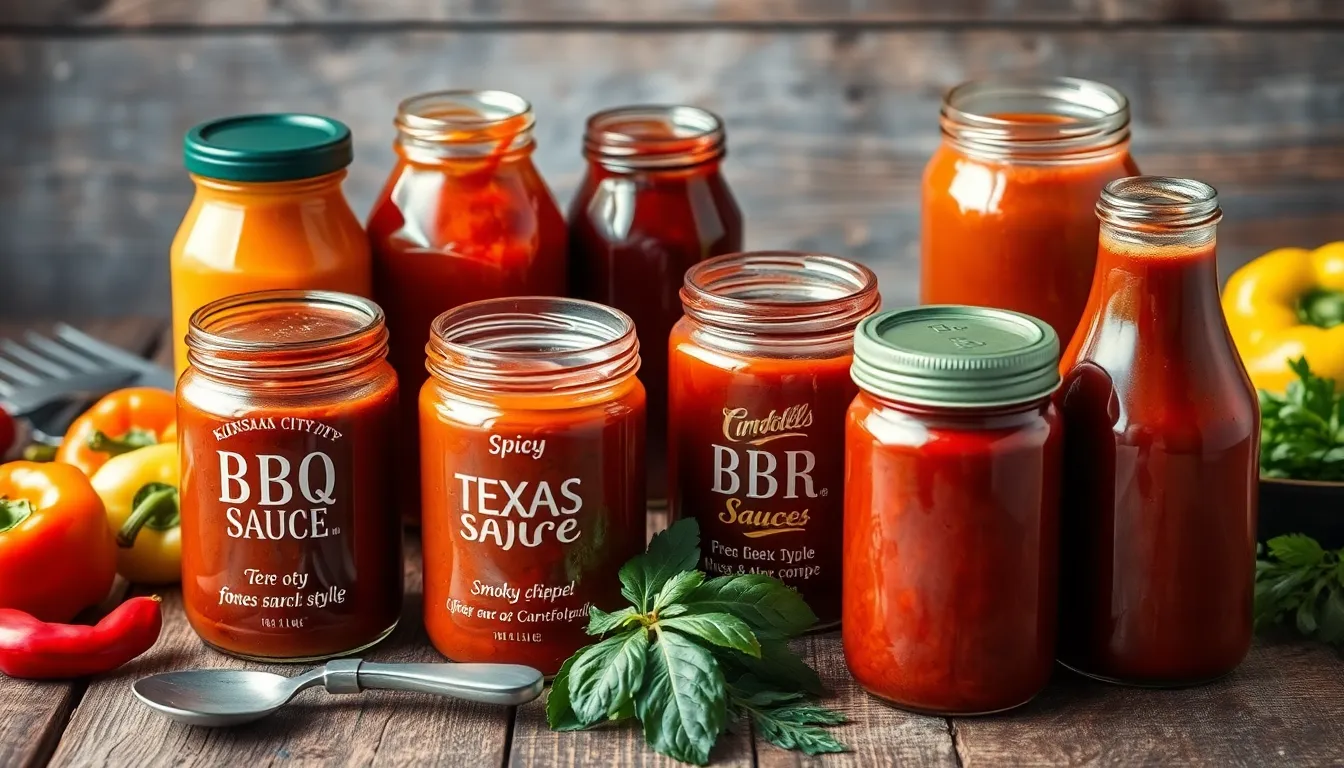
Once you master our basic BBQ sauce recipe, we can explore regional variations that transform this foundation into authentic styles from across America. Each variation brings distinct flavor profiles that pair perfectly with exact meats and cooking methods.
Kansas City Style
Kansas City BBQ sauce represents the thick, sweet, and glossy standard that most people recognize. We build this version with a ketchup base, adding generous amounts of molasses and brown sugar for deep sweetness. Apple cider vinegar provides the necessary tang to balance the sugars, while garlic powder, onion powder, and liquid smoke create that signature Kansas City depth.
Our Kansas City sauce requires longer simmering until it reaches a glossy, coating consistency. This thickness makes it perfect for ribs and beef brisket, where the sauce needs to cling and caramelize during cooking. We recommend brushing this sauce on meats during the last 10 minutes of grilling to prevent burning the sugars.
Carolina Style
Carolina BBQ sauce splits into two distinct regional approaches that we love for their simplicity and punch. Eastern North Carolina style focuses on apple cider vinegar as the primary base, creating a thin, tangy sauce that penetrates meat rather than coating it. We add just a touch of sugar, red pepper flakes, and salt to this vinegar foundation.
South Carolina takes a different approach by incorporating yellow mustard into the vinegar base. This creates a sharp, tangy flavor with a distinctive yellow color that cuts through rich pork perfectly. We balance the mustard’s bite with a small amount of brown sugar and enhance it with cayenne pepper for heat. Both Carolina styles work exceptionally well with pulled pork, where the thin consistency allows the sauce to soak into the meat fibers.
Texas Style
Texas BBQ sauce emphasizes savory and spicy elements over sweetness, reflecting the state’s preference for letting meat flavors shine. We start with a tomato base but add substantial amounts of chili powder, cumin, and Worcestershire sauce to create complexity. This sauce includes some sweetness but far less than Kansas City style.
Our Texas version achieves a medium thickness that clings to brisket and ribs without overwhelming their smoky flavors. We incorporate chipotle powder or smoked paprika for authentic smokiness, and black pepper for a sharp bite. The result is a sauce that complements rather than masks the meat’s natural flavors, making it ideal for Texas-style brisket and beef ribs.
Spicy Chipotle Version
Our spicy chipotle variation brings smoky heat that elevates any BBQ dish. We incorporate chipotle peppers in adobo sauce or chipotle chili powder into our ketchup base, creating layers of flavor that build from smoky to spicy. Brown sugar and honey balance the heat while apple cider vinegar adds brightness.
Garlic powder, onion powder, and cumin enhance the earthy flavors, while a splash of lime juice provides unexpected freshness. We simmer this sauce until all flavors meld together, creating a complex profile that works beautifully with chicken, pork, and beef. The chipotle peppers provide both heat and smokiness, making this variation perfect for those who want restaurant-quality spice in their homemade sauce.
Storage Instructions
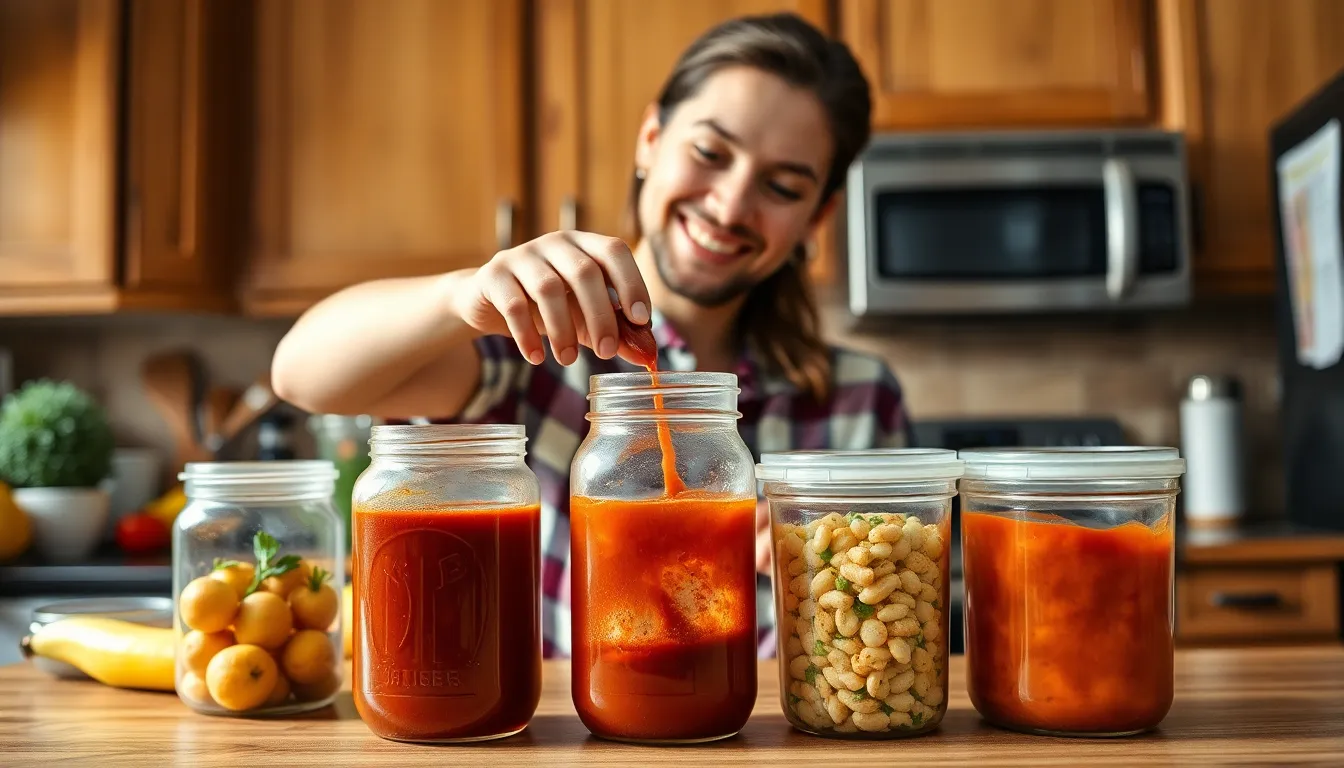
Once you’ve perfected your homemade BBQ sauce, proper storage ensures it maintains its bold flavors and quality for weeks or even months. We’ll guide you through the best methods to preserve your sauce’s taste and freshness.
Refrigerator Storage
Allow your BBQ sauce to cool to room temperature before transferring it to storage containers. We recommend using clean mason jars with tight-fitting lids or other airtight containers to maintain freshness and prevent contamination.
Store your homemade BBQ sauce in the refrigerator for 7 to 14 days depending on the recipe’s acidity and salt content. Most basic BBQ sauce recipes stay fresh for about a week, though higher-acid and well-salted versions can last up to two weeks safely.
| Storage Duration | Sauce Type | Container |
|---|---|---|
| 7 days | Basic homemade BBQ sauce | Airtight container |
| 14 days | High-acid/salt BBQ sauce | Mason jar with tight lid |
Fill containers with minimal headspace to maximize shelf life and reduce air exposure. Your sauce serves perfectly as a marinade, basting sauce during grilling, or condiment for chicken, pork, burgers, and even pizza throughout its refrigerated storage period.
Freezing Options
Transfer your cooled BBQ sauce to freezer-safe containers for longer storage periods. Properly frozen homemade BBQ sauce maintains its quality for 3 to 6 months, with most recipes staying at peak flavor for about 3 months.
When you’re ready to use frozen sauce, thaw it in the refrigerator overnight or at room temperature for faster results. Stir the sauce well after thawing since some separation naturally occurs during the freezing process.
We suggest portioning your sauce into smaller containers before freezing, making it easier to thaw only what you need for exact meals. This method prevents repeated freeze-thaw cycles that can affect texture and flavor quality.
Make-Ahead Tips
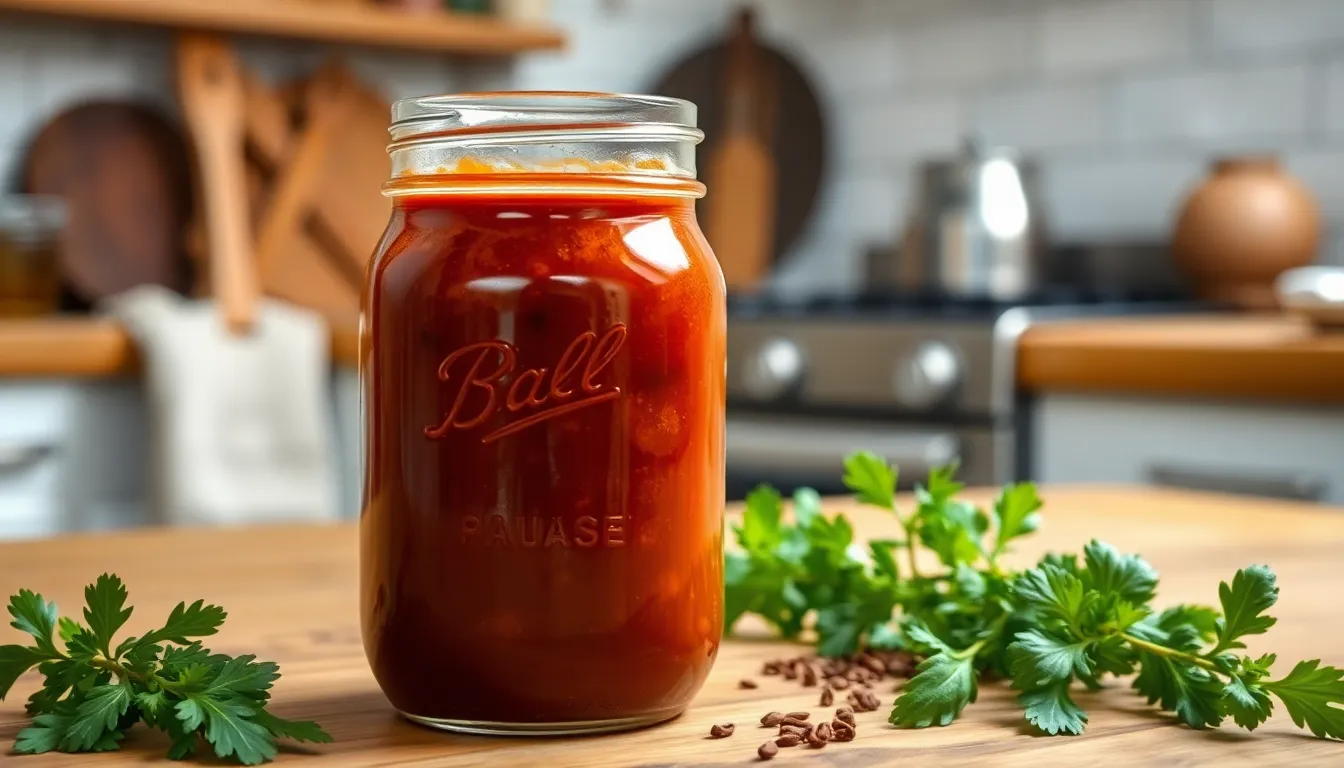
Making our homemade BBQ sauce a day ahead significantly enhances its flavor profile as the ingredients meld together over time. We recommend preparing the sauce at least 24 hours before you plan to use it for optimal taste development.
Storage containers play a crucial role in maintaining sauce quality. Glass jars work exceptionally well for storing our BBQ sauce, as they don’t absorb flavors or odors like plastic containers might. Mason jars with tight-fitting lids create an airtight seal that preserves freshness for up to 3 weeks in the refrigerator.
Refrigeration timing affects the sauce’s final flavor balance. After cooking, we suggest letting the sauce rest in the refrigerator for at least one hour before serving. This resting period allows the initial spiciness and vinegar sharpness to mellow, creating a more harmonious flavor profile.
Freezing options extend storage life considerably. Our BBQ sauce freezes beautifully for up to 3 months without losing its rich taste or texture. Pour the cooled sauce into freezer-safe containers, leaving about an inch of headspace to allow for expansion during freezing.
Thawing preparation requires overnight planning. Transfer frozen sauce to the refrigerator and allow it to thaw completely overnight before use. This gradual thawing process maintains the sauce’s smooth consistency and prevents separation.
Batch cooking maximizes efficiency in the kitchen. We often double or triple our recipe when making BBQ sauce, as the cooking time remains essentially the same. This approach provides multiple jars of sauce for future grilling sessions while the stove is already in use.
Flavor development continues during storage. The sauce actually improves with time as the spices integrate more fully with the base ingredients. We’ve found that sauce stored for several days develops deeper, more complex flavors than freshly made versions.
Serving Suggestions
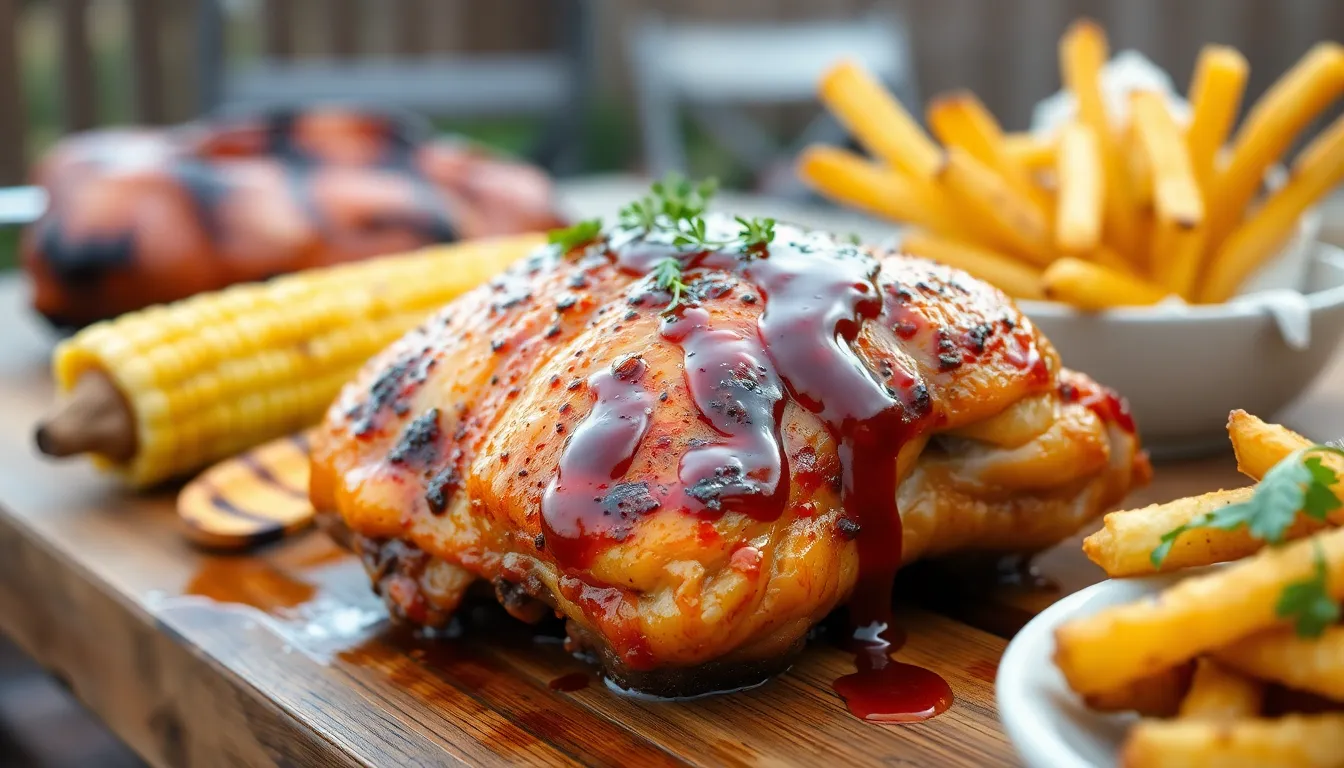
Our homemade BBQ sauce transforms into a culinary powerhouse that elevates countless dishes beyond traditional barbecue applications. We recommend using this versatile sauce as a marinade to infuse deep flavor into meat before grilling starts. The sauce penetrates proteins beautifully when applied 2-4 hours before cooking.
Brushing the sauce onto meats during grilling or roasting creates an irresistible caramelized glaze that locks in moisture. We suggest applying it during the final 10-15 minutes of cooking to prevent burning while achieving that perfect sticky coating. This technique works exceptionally well with ribs, chicken thighs, and pork shoulders.
Beyond the grill, our BBQ sauce excels as a dipping companion for grilled chicken wings, tender ribs, juicy burgers, and crispy french fries. We find that serving it alongside these favorites creates an interactive dining experience that guests love. The sauce maintains its consistency at room temperature, making it ideal for outdoor gatherings.
Kitchen creativity flourishes when we incorporate this sauce into everyday cooking. Adding a generous spoonful to baked beans transforms a simple side dish into a standout accompaniment. We also recommend using it as a sandwich spread to add depth to pulled pork, grilled chicken, or even veggie burgers.
The sauce’s balanced sweet and tangy profile makes it an excellent glaze for roasted vegetables like carrots, Brussels sprouts, or sweet potatoes. We brush it on during the last few minutes of roasting to create caramelized edges without overpowering the natural flavors.
Pizza enthusiasts will appreciate using our BBQ sauce as an alternative base to traditional tomato sauce, especially when topped with grilled chicken, red onions, and fresh cilantro. This combination creates a restaurant-quality meal that rivals any takeout option.
Conclusion
We’ve shown you how simple it is to create restaurant-quality BBQ sauce right in your own kitchen. With just a few pantry staples and 20 minutes of your time you can create a sauce that’s perfectly customized to your taste preferences.
The beauty of homemade BBQ sauce lies in its versatility and freshness. Whether you’re grilling for a weekend cookout or meal prepping for the week ahead this sauce will transform your dishes with its bold sweet and tangy flavors.
Don’t settle for store-bought when you can make something infinitely better at home. Try our recipe tonight and discover why homemade BBQ sauce is a game-changer for your cooking.
Frequently Asked Questions
How long does homemade BBQ sauce last in the refrigerator?
Homemade BBQ sauce can be stored in the refrigerator for 7 to 14 days when kept in airtight containers like mason jars. The exact shelf life depends on the recipe’s acidity and salt content. For longer storage, you can freeze the sauce in freezer-safe containers for 3 to 6 months while maintaining quality.
What are the essential ingredients for homemade BBQ sauce?
The base ingredients include ketchup, apple cider vinegar, Worcestershire sauce, and finely diced onion. Sweeteners like brown sugar, honey, and molasses add depth. Essential spices include smoked paprika, garlic powder, and cayenne pepper. Optional flavor enhancers like tomato paste, liquid smoke, and bourbon can add extra complexity to your sauce.
How long does it take to make homemade BBQ sauce?
Homemade BBQ sauce requires only 20 minutes of preparation time. The cooking process involves bringing the mixture to a boil, then simmering for 10-20 minutes to achieve the desired thickness and flavor concentration. You may extend cooking time for deeper flavor development if preferred.
Can I customize the heat level in my BBQ sauce?
Yes, you can easily adjust the heat level by modifying the amount of cayenne pepper or adding other spicy ingredients. For a milder sauce, reduce or omit the cayenne pepper. For more heat, increase the cayenne or add hot sauce, jalapeños, or chipotle peppers to suit your taste preferences.
What kitchen equipment do I need to make BBQ sauce?
You only need basic kitchen equipment: a large saucepan for simmering, measuring cups and spoons for accurate ingredient portions, and a whisk or wooden spoon for mixing. An airtight storage container or mason jar is recommended for refrigerator storage. Most home cooks already have these essential tools.
Should I let my BBQ sauce rest before using it?
Yes, allowing your BBQ sauce to rest in the refrigerator for at least an hour before serving helps the flavors meld together for a more harmonious taste. Making the sauce a day in advance is even better, as the ingredients continue to develop deeper, more complex flavors over time.
What are some ways to use homemade BBQ sauce?
BBQ sauce is incredibly versatile beyond traditional barbecue. Use it as a marinade for meats, brush it on during grilling for caramelization, or serve as a dipping sauce for wings and burgers. It also enhances baked beans, works as a sandwich spread, and can even be used as a pizza base.
What’s the difference between regional BBQ sauce styles?
Kansas City style is thick, sweet, and glossy with molasses. Carolina has two variations: Eastern North Carolina uses tangy vinegar, while South Carolina features mustard. Texas style focuses on savory and spicy elements with chili powder and cumin. Each region reflects distinct flavor preferences and cooking traditions.

